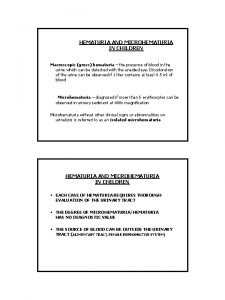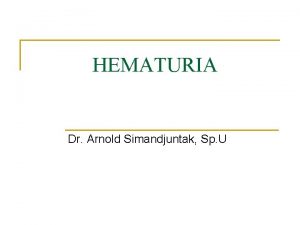Hematuria Urology Department Ain Shams University 2009 Hematuria



















- Slides: 19

Hematuria Urology Department Ain Shams University, 2009

Hematuria • Hematuria means the presence of blood in urine, and more precisely the presence of red blood cells based on microscopic examination of urinary sediment from a freshly voided urine specimen. • It may be gross or microscopic. • Greater than three red blood cells per high-power microscopic field (HPF) is significant. • The blood may originate from the kidney (Nephrologic) or the collecting system (Urologic). • The prevalence of asymptomatic microscopic hematuria varies from 0. 2 percent to as high as 20 percent. Urology Department Ain Shams University, 2009

Hematuria • Hematuria of any degree should never be ignored and, painless hematuria in adults, should be regarded as a symptom of urologic malignancy until proved otherwise. • The most common cause of gross hematuria in a patient older than age 50 years is bladder cancer. Urology Department Ain Shams University, 2009

Hematuria In evaluating hematuria, several questions should always be asked: • Is hematuria gross or microscopic? • At what time during urination does hematuria occur (beginning or end of stream or during entire stream)? • Is hematuria associated with pain? • Is the patient passing clots? • If the patient is passing clots, do the clots have a specific shape? Urology Department Ain Shams University, 2009

Hematuria Gross versus Microscopic Hematuria • The significance of gross versus microscopic hematuria is simply that the chances of identifying significant pathology increase with the degree of hematuria. Urology Department Ain Shams University, 2009

Hematuria Timing of hematuria Bleeding is classified by when it occurs during urination, which may indicate the location of the problem. • Onset of urination (initial hematuria)–urethra • Throughout urination (total hematuria)–bladder, ureter, or kidneys • End of urination (terminal hematuria)–bladder or prostate (men) Urology Department Ain Shams University, 2009

Hematuria Association with Pain Hematuria, although frightening, is usually painless unless it is associated with inflammation or obstruction. Urology Department Ain Shams University, 2009

Hematuria Presence of Clots The presence of clots usually indicates a more significant degree of hematuria. Shape of Clots • Usually, if the patient is passing clots, they are amorphous and of bladder or prostatic urethral origin. • The presence of vermiform (wormlike) clots, particularly if associated with flank pain, identifies the hematuria as coming from the upper urinary tract with formation of vermiform clots within the ureter. Urology Department Ain Shams University, 2009

Hematuria Causes Common causes include: • Urinary tract infection, • Urinary tract tumors, • Urinary tract calculi, • Urethritis, • Benign prostatic hypertrophy and • Prostate cancer. Urology Department Ain Shams University, 2009

Hematuria Differential Diagnosis Other causes of red or dark urine: • Hemoglobinuria: dipstick positive but NO red cells on microscopy. • Myoglobinuria. • Food, e. g. beetroot. • Drugs, e. g. rifampicin, nitrofurantoin and senna. • Porphyria: urine darkens on standing. • Bilirubinuria: obstructive biliary disease. Urology Department Ain Shams University, 2009

Hematuria Diagnosis • Take a full urological history. • Family history may reveal inherited predispositions to kidney stone disease, sickle cell anemia, von Hippel-Lindau disease, or another genetic disorder associated with hematuria. • A thorough physical examination is performed, with emphasis on the urinary tract, abdomen, pelvis, genitals, and rectum. Urology Department Ain Shams University, 2009

Hematuria Investigations • All patients with hematuria, whether macroscopic or microscopic, require investigation to exclude serious underlying conditions, especially urinary tract neoplasm. • Patients on anticoagulants should also be investigated. Anticoagulants are more likely to provoke rather than be the cause of hematuria. Urology Department Ain Shams University, 2009

Hematuria Laboratory • Check full blood count (anemia), renal function and blood coagulation profile. • Urinary microscopy and culture. • Urine red cell morphology: dysmorphic erythrocytes suggest a renal origin. • Cytological examination of urine for exfoliated malignant cells. Urology Department Ain Shams University, 2009

Hematuria Imaging • Ultrasound of renal tract: Ultrasound is as sensitive as intravenous urography and more cost-effective. • A plain film of the abdomen to rule out urinary calculi. • Cystoscopy: important in younger as well as older patients. • Renal biopsy in nephrologic causes. • Intravenous urography is indicated if urinary tract stones are suspected or if ultrasound, plain x-ray and cystoscopy are negative. • Renal angiography or CT scanning are indicated in specific circumstances. Urology Department Ain Shams University, 2009

Hematuria • If a definite diagnosis cannot be made, investigations should be repeated whenever gross hematuria occurs or after 3 -6 months. Occult cancer will usually show within a year. • When no specific cause can be found, bladder and kidney life-threatening diseases can be ruled out. The possible causes that remain include conditions that may correct themselves, or the hematuria may be idiopathic. Urology Department Ain Shams University, 2009

Hematuria Features suggesting a renal (Nephrologic) cause include: • Hypertension, • Altered renal function tests, • Proteinuria, • Known previous renal problems, and • Glomerular (dysmorphic) red cells in urine. Urology Department Ain Shams University, 2009

Hematuria Urgent referral to urologist is recommended for: • Patients of any age with painless macroscopic hematuria. • Aged 40 years and older who present with recurrent or persistent urinary tract infection associated with hematuria. • Aged 50 years and older who are found to have unexplained microscopic hematuria. • With an abdominal mass identified clinically or on imaging that is thought to arise from the urinary tract. Urology Department Ain Shams University, 2009

Hematuria Treatment • Treatment ranges from antibiotic therapy to surgery, depending on the underlying cause. Urology Department Ain Shams University, 2009

Thank You
 Shams al ma'arif
Shams al ma'arif Pătrate magice
Pătrate magice Ehsan shams
Ehsan shams Sana shams
Sana shams Maitham shams
Maitham shams 10 mgd
10 mgd Macroscopic hematuria causes
Macroscopic hematuria causes Fountain valley hematuria
Fountain valley hematuria Eritrocitos isomorficos
Eritrocitos isomorficos Hematuria
Hematuria Hematuria
Hematuria Hematuria causes
Hematuria causes Anuria disuria poliuria oliguria hematuria
Anuria disuria poliuria oliguria hematuria Oxalato de calcio
Oxalato de calcio Hematuria ex vacuo
Hematuria ex vacuo Donald lamm md
Donald lamm md Dr donaldson urology
Dr donaldson urology Laura oakley
Laura oakley Urology match
Urology match Urology match
Urology match




































